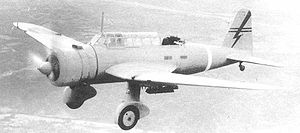Mitsubishi Ki-30 Video - Picture

|
|
Mitsubishi Ki-30
Ki-30

Picture - Mitsubishi Ki-30
Role: Light bomber
Manufacturer: Mitsubishi
First flight: 28 February 1937
Introduced: January 1938
Primary users: Imperial Japanese Army Air Force
Royal Thai Air Force
Produced: 1938-1941
Number built: 704
The Mitsubishi Ki-30 (ä¹ä¸å¼è»½çææ©, Kyunana-shiki keibakugekiki) was a Japanese light bomber of World War II. It was a single-engine, mid-wing, cantilever monoplane of stressed-skin construction with a fixed tailwheel undercarriage and a long transparent cockpit canopy. The type had significance in being the first Japanese aircraft to be powered by a modern two-row radial engine. During the war, it was known by the Allies by the name Ann.
Design and development
The Ki-30 was developed in response to a May 1936 Imperial Japanese Army specification to replace the Kawasaki Ki-3 light bomber with a completely indigenously designed and built aircraft. Mitsubishi and Kawasaki were requested to build two prototypes each by December 1936. The specification called for a top speed of 400 km/h (250 mph) at 3,000 m (9,840 ft); normal operating altitude from 2,000 m (6,560 ft) to 4,000 m (13,130 ft), the ability to climb to 3,000 m (9,840 ft) within eight minutes and an engine to be selected from the 634 kW (850 hp) Mitsubishi Ha-6 radial, 615 kW (825 hp) Nakajima Ha-5 radial, or 634 kW (850 hp) Kawasaki Ha-9-IIb liquid-cooled inline engines, a normal bomb load of 300 kg (660 lb) and a maximum of 450 kg (990 lb), one forward-firing machine gun and one flexible rearward-firing machine gun, the ability to perform 60° dives for dive bombing, and a loaded weight less than 3,300 kg (7,280 lb).
The first Mitsubishi prototype flew on 28 February 1937 powered by a Mitsubishi Ha-6 radial. Originally, designed with a retractable main landing gear, wind tunnel tests indicated that the gain in speed was minimal due to the landing gear's extra weight and complexity and a fixed arrangement with "spatted" main wheels was chosen instead. The wing was mounted at a point above the line of the aircraft's belly in order fully enclose the bomb bay within the fuselage. The pilot sat just above the leading edge of the wing, and the rear-gunner/radio-operator just behind the wing trailing edge, in a long "greenhouse" canopy which gave both crewmen excellent all-around vision. The Ha-6 engine drove a three-blade variable-pitch propeller.
A second prototype, fitted with the slightly more powerful Nakajima Ha-5 engine, was completed the same month. Although two months behind schedule and overweight, both prototypes met or exceeded every other requirement. The second prototype's top speed of 423 km/h (263 mph) at 4,000 m (13,130 ft) led the Imperial Japanese Army Air Force to place an order for 16 service trials machines. These were delivered in January 1938 and the result of the trials was that the Army ordered the Ki-30 into production in March under the designation Army Type 97 Light bomber.
Mitsubishi built 618 production machines through April 1940, and the 1st Army Air Arsenal (Tachikawa Dai-Ichi Rikugun Kokusho) built 68 more by the time production ceased in September 1941. Including prototypes, a total of 704 Ki-30s were built.
Operational history
The Ki-30s were first used in combat in Second Sino-Japanese War from spring 1938. It proved to be reliable in rough field operations, and highly effective while operating with fighter escort. This success continued in the early stages of the Pacific War, and the Ki-30s participated extensively in operations in the Philippines. However, once unescorted Ki-30s met Allied fighters, losses mounted rapidly and the type was soon withdrawn to second-line duties. By the end of 1942, most Ki-30s were relegated to a training role. Many aircraft were expended in kamikaze attacks towards the end of the war.
From late 1940, the Ki-30 was in service with the Royal Thai Air Force, and saw combat in January 1941 against the French in French Indochina in the French-Thai War. Additional Ki-30s were transferred from Japan in 1942.
Operators
World War II
Japan
Imperial Japanese Army Air Force
No. 82 Dokuritsu HikÅ Chutai IJAAF
No. 87 Dokuritsu HikÅ Chutai IJAAF
No. 6 HikÅ Sentai IJAAF
No. 16 HikÅ Sentai IJAAF
No. 31 HikÅ Sentai IJAAF
No. 32 HikÅ Sentai IJAAF
No. 35 HikÅ Sentai IJAAF
No. 90 HikÅ Sentai IJAAF
Thailand
Royal Thai Air Force
Post-war
People's Republic of China
Chinese Communist Air Force operated three captured Ki-30s were used as trainers until early 1950s.
Specifications (Ki-30)
Data from Japanese Aircraft of the Pacific War
General characteristics
Crew: 2, pilot and observer/bomb aimer
Length: 10.35 m (33 ft 11.5 in)
Wingspan: 14.55 m (47 ft 8.75 in)
Height: 3.65 m (11 ft 11.75 in)
Wing area: 30.58 m² (329.17 ft²)
Empty weight: 2,230 kg (4,916 lb)
Loaded weight: 3,320 kg (7,324 lb)
Powerplant: 1x Nakajima Ha-5-kai 14-cylinder double-row air-cooled radial engine, 708 kW (950 hp)
Performance
Never exceed speed: 442 km/h (239 kn, 275 mph)
Maximum speed: 423 km/h (228 kn, 263 mph)
Cruise speed: 380 km/h (205 kn, 236 mph)
Range: 1,700 km (918 nmi, 1,066 mi)
Service ceiling: 8,570 m (28,115 ft)
Rate of climb: 8.33 m/s (1,640 ft/min)
Wing loading: 108.6 kg/m² (22.3 lb/ft²)
Armament
2x 7.7 mm (0.303 in) Type 89 machine guns (one fixed wing-mounted and another manually aimed from the rear cockpit)
400 kg (882 lb) bombload
Comparable aircraft
Kawasaki Ki-32
Heinkel He 70
Fairey Battle
A-35 Vengeance
PZL.23 KaraÅ
Bibliography
Francillon, Ph.D., René J. (1979). Japanese Aircraft of the Pacific War. London: Putnam & Company Ltd.. ISBN 0-370-30251-6.
Gunston, Bill (1999). The Illustrated Directory of Fighting Aircraft of World War II. London: Zenith Press. ISBN 0-86101-390-5.
Lake, Jon (2002). Great Book of Bombers. Zenith Press. ISBN 0-76031-347-4.
Mikesh, Robert C.; Shorzoe Abe (1990). Japanese Aircraft 1910-1941. Annapolis, MD: Naval Institute Press. ISBN 1-55750-563-2.
Mondey, David (2002). The Concise Guide to Axis Aircraft of World War II. Chancellor Press. ISBN 1 85152 966 7.
Mitsubishi Ki-30 Pictures
Living Warbirds: The best warbirds DVD series.
Source: WikiPedia